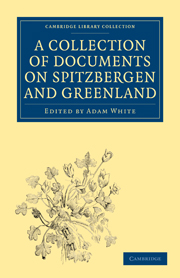 A Collection of Documents on Spitzbergen and Greenland
A Collection of Documents on Spitzbergen and Greenland Book contents
- Frontmatter
- INTRODUCTION
- PART THE FIRST VOYAGE INTO SPITZBERGEN AND GREENLAND
- PART THE SECOND CONTAINING THE DESCRIPTION OF SPITZBERGEN
- PART THE THIRD
- PART THE FOURTH OF THE ANIMALS OF SPITZBERGEN
- CHAP. I Of Birds with Toes or Divided Feet
- CHAP. II Of the Broad or Web-Footed Birds
- CHAP. III Of some other Birds that I did not Catch or Delineate
- CHAP. IV Of the Four-Footed Creatures
- CHAP. V Of the Crustaceous Fish that I Observed
- CHAPTER VI
- CHAPTER VII Of the Whale
- CHAP. VIII How they Catch the Whale
- CHAP. IX What they do with the Dead Whale
- CHAP. X Of the Trying out of the Train-Oyl from the Fat
- CHAPTER XI Of the Finn-Fish
- CHAP. XII Of Rotz-fishes and Sea-qualms
- LIST OF THE ANIMALS OF SPITZBERGEN
- DESCRIPTION OF GREENLAND
- INDEX
- Plate section
CHAP. I - Of Birds with Toes or Divided Feet
Published online by Cambridge University Press: 05 June 2011
- Frontmatter
- INTRODUCTION
- PART THE FIRST VOYAGE INTO SPITZBERGEN AND GREENLAND
- PART THE SECOND CONTAINING THE DESCRIPTION OF SPITZBERGEN
- PART THE THIRD
- PART THE FOURTH OF THE ANIMALS OF SPITZBERGEN
- CHAP. I Of Birds with Toes or Divided Feet
- CHAP. II Of the Broad or Web-Footed Birds
- CHAP. III Of some other Birds that I did not Catch or Delineate
- CHAP. IV Of the Four-Footed Creatures
- CHAP. V Of the Crustaceous Fish that I Observed
- CHAPTER VI
- CHAPTER VII Of the Whale
- CHAP. VIII How they Catch the Whale
- CHAP. IX What they do with the Dead Whale
- CHAP. X Of the Trying out of the Train-Oyl from the Fat
- CHAPTER XI Of the Finn-Fish
- CHAP. XII Of Rotz-fishes and Sea-qualms
- LIST OF THE ANIMALS OF SPITZBERGEN
- DESCRIPTION OF GREENLAND
- INDEX
- Plate section
Summary
Of land-birds I observed but one sort, viz.:
Of a Snite.
This snite, which is also called the strand runner (because it keepeth about the strand), is no bigger than a lark.
Its bill narrow, thin, and corner'd withall. Our snites’ bills are at the farther end broader and roundish, and cut in with cross notches like a rasp to rasp wood withall; so that the whole upper jaw and bill looketh exactly like a rasp with its handle. Our snites are also bigger than those of Spitzbergen, otherwise they are very like one another in shape and colour; this bill, both above and below, is four square, of a brownish colour, and about two inches long. The head is roundish, and of the same thickness with the neck.
Their feet are made of three divided claws before, and one behind, which is very short; their legs are not very long. It is of the colour of a lark; but when the sun shines upon it, it shews blewish, very like those two colours observed on our ducks’ necks when the sun shines upon them: they feed upon the little gray worms and shrimps. We shot some of them in the South Harbour, near the cookery of Harlem: they had not the taste of fish at all.
- Type
- Chapter
- Information
- A Collection of Documents on Spitzbergen and GreenlandComprising a Translation from F. Martens' Voyage to Spitzbergen, a Translation from Isaac de La Peyrère's Histoire du Groenland, and God's Power and Providence in the Preservation of Eight Men, pp. 57 - 59Publisher: Cambridge University PressPrint publication year: 2010First published in: 1855


